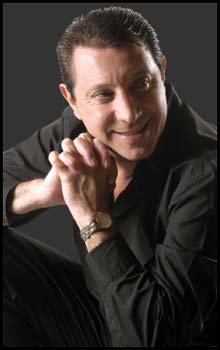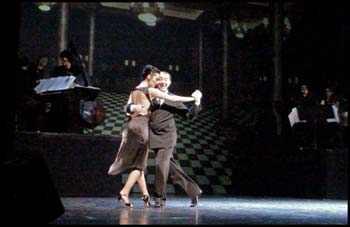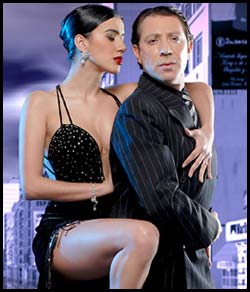By
Zotto - Miguel Ángel Zotto, multi-skilled and creative

lease dance a tango, Zotto! We feel like saying that when we come across him on Corrientes Avenue on one of those scarce occasions he is in our city. Unknown for those who have seen onstage because he is like another common boy: he usually wears a regular t-shirt, a loosely hairstyle. Don’t expect to see a Gardel-like hairdo, black and shiny, nor a tuxedo or patent leather shoes. He’s always in a hurry.
 We are inclined to guess he is in a hurry because of a rehearsal or for something connected with his evening performance. He’s all work and seriousness. Then while he is onstage, yes there, we do feel like shouting: Dance a tango, Carlitos! Or, in other words, Miguel Ángel Zotto, because at that time it’s the same. And the applause by the audience underline this. Here like in every corner of the world where he has danced.
We are inclined to guess he is in a hurry because of a rehearsal or for something connected with his evening performance. He’s all work and seriousness. Then while he is onstage, yes there, we do feel like shouting: Dance a tango, Carlitos! Or, in other words, Miguel Ángel Zotto, because at that time it’s the same. And the applause by the audience underline this. Here like in every corner of the world where he has danced.
—Zotto, you’ve just premiered your show Puro Tango, how has the idea of this new proposal appeared?
«Twenty-six years ago I interviewed Petróleo —a famous dancer who died in 1995— with my first video camera. I had already filmed some other milongueros. It was in January and I went to visit him at the boarding house where he lived. And that lasted, with some interruptions, for two years.
«I wanted to know about the history of tango dancing. I didn’t take shots of his dancing, he scarcely showed me some steps. What was most important were his tales about the way each character danced, when, where and who had created certain figures. Petróleo saw dancing everybody because he was born in 1911 and he started with tango when he was around ten years old. He saw El Negro Navarro, a contemporary of El Cachafaz, that had learned with Pedrín de San Telmo, the first tango dancer.
«He saw El Cachafaz with all the female partners he had, and also Méndez, the best of the 30s. In the 40s the most important was El Vasco Orradre, a close friend of his and dancer of Juan D'Arienzo, who, besides his orchestra, also had dancers. El Vasco invented the counter step and then he revolutionized everything.
«By the end of that decade, with other orchestras and other needs of movement, some boys gathered and said: «We are dancing the way it was done twenty years ago, we have to invent something». So El Negro Lavandina thought that the female dancer, instead of walking, had to turn around the male dancer. These guys invented turns, coils, hooks. Men used to meet to invent steps and to practice.
«Petróleo was from Monte Castro, a small neighborhood to the north of Villa Luro. Lavandina was from Villa Urquiza.
«I found some things that Petróleo had written in which he said that once, in the thirties, he had organized a milonga that included a prize for the most outstanding dancers. One of the artists he wanted to award was María Ruanova, a leading dancer at the ballet of the Teatro Colón. He always attended the ballet performances. Among so many dancers, he had seen Oscar Araiz in his beginnings.
«Petróleo was not a professional dancer, he had a job as clerk in a bank and directed the magazine of that institution. Every month he wrote an article about tango in that publication.»

—What happened after Petróleo and before the time of your new show?
«After many years of teaching how to dance, especially in Europe, I discovered that the woman has a leitmotiv in dancing: the figure that represents «the eight». In the development of tango dancing in all styles the first movement is «the eight». The question that I made myself then was: How can explain people that with «the eight» the UNESCO declared tango as heritage of mankind? Because it is the main movement. In all the combinations of steps what the students do not learn, at least in Europe, is the mark of «the eight». People would be able to dance better if they learned that abc in a simple way. When I asked Petróleo (1985): Don’t you think that by codifying the way of teaching how to dance would make it easier for people? He replied: «The eight ought to be regarded as the basis». At that time I didn’t understand. Twenty-five years had to pass and I was so interested in the subject that it led me to numerology.
«The eight is the symbol that stands for infinite. In numerology even numbers are femenine, and the figure of the eight in tango is performed by a woman, not by a man. The eight is a guitar, is the woman’s silhouette. See what happened. I began to write a script for the show with a series of numbered scenes and one of the scenes is dedicated to my brother Osvaldo; later I realized it is the scene number eight».
—Have you made use of material you had previously recorded for this show?
«Yes. It is a combination, for example, I choose a choreography copied from El Cachafaz, I dance like Los Méndez and stage a scene like what Petróleo told me about the dancing academias. The first part of the show is inspired in these legendary tango figures. I also include projection of images. A scene takes place at the well-remembered Palermo Palace and Petróleo’s voice mentions the names of the characters that the dancers of the cast and I impersonate: “Rafael, El Rey de la Raspada”, or a guy of Almagro known as La Biblia because he remembered all the steps and dancing figures.
«They all respected each other and, when someone made an exhibition the others went to see him. But among them there was also rivalry. When I started to make recordings each milonguero told me that he had invented all. No one had had a teacher. But then I met Petróleo and Antonio Todazo and they did not speak evil of anyone and admitted they had learned from somebody else. But certainly all them tried to have something of their own, a personal style».
—Why is it called Puro Tango?
«Because it is truly tango. We do not play anything by Piazzolla and we close with Pugliese. Of course, in certain scenes some couples do things that are more stylized. This first section in which I reminisce all what I have told you is, in fact, an introduction that I close by saying to the audience: «Thanks to all this people tango is being danced throughout the world today».
«There is a homage to my brother in which Giselle takes part. She was his last couple. And in the other scenes either a short story is told or they are plain choreographies. But it’s tango tango. A great number includes Daiana who wears a dress that becomes a curtain. It’s quite interesting but it’s very hard work for me.
«I, alone, am responsible for the whole show. I always did that way. It’s very difficult for me to work with other people. While on tour new ideas come to my mind and I take them down, even the lights I’m going to use. When I arrive in Buenos Aires I have all the things almost ready. I have collaborators, of course, but nearly everything depends on me.
«On the tours I don’t change anything, on the contrary, I want that they know who is each one of the characters just the way they are. I name them in Italian. People won’t understand anything, but here no one will understand anything either. It does not matter, Rafael, La Biblia, Petróleo and the others will be there. The essence of tango will be there.
Published in the Clarín newspaper on January 14, 2011.
Zotto was born in Vicente López, province of Buenos Aires, a city next to the north of the Capital. He is grandson and son of tango dancers. He began to dance at home and when he was a teenager he visited the traditional dancing venues.
In his development as dancer there were several characters but when he was seventeen he met Los Dinzel, an everlasting marriage in life and in dancing. With Rodolfo Dinzel he studied hardly for six years. He suggested Dinzel as instructor in the Universidad de Belgrano.
 In 1985, as a professional, he teamed up with Milena Plebs who had a classical ballet training. They appeared at Michelángelo in a show entitled Jazmines, and the choreographer was Ana María Stekelman. After that they made tours, taught in different seminars, even teaching the Teatro Colón dancers.
In 1985, as a professional, he teamed up with Milena Plebs who had a classical ballet training. They appeared at Michelángelo in a show entitled Jazmines, and the choreographer was Ana María Stekelman. After that they made tours, taught in different seminars, even teaching the Teatro Colón dancers.
The dancing couple appeared at the successful show Tango Argentino, that was staged in 56 cities of North America and Europe. In 1988 they continued on their own and created the TangoX2 company. Their first show was firstly staged in Argentina and later worldwide. Later, Perfumes de Tango.
In 1991 they staged —at the Opera of Houston (Texas)— the little opera by Astor Piazzolla and Horacio Ferrer, “María de Buenos Aires”, and he played one of the main roles. A new show in 1997: Una Noche de Tango. In 2000 Dos por Dos, symphonic tango. In 2003 Tangos en la Cruz del Sur, that the following year, after an adaptation, was presented in Italy as: Tangos: Una leyenda. Finally, due to personal reasons, Zotto and Plebs broke up. Now his present partner is Daiana Guspero.